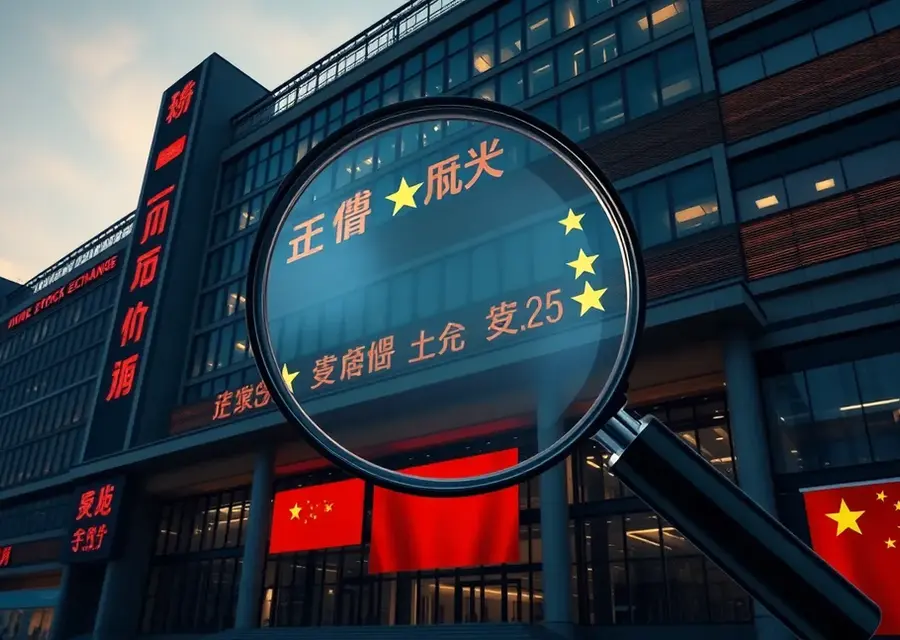China securities regulator probe: What it means for markets and governance
- THE MAG POST

- Sep 7
- 5 min read

China securities regulator probe exposes fault lines between rapid market liberalization and strict gatekeeping, underscoring how anti-corruption imperatives shape financial policy. In the wake of the investigation into the former chair, investors and policymakers confront a landscape marked by uncertainty about governance norms, accountability, and the pace of reform. The episode invites a closer look at how regulators balance openness with rigorous oversight, how market participants price risk, and what reforms might emerge to strengthen credibility without stifling innovation. This analysis expands beyond headlines, drawing on historical context, comparative cases, and practical implications for markets and governance.
The initial context paragraph introduces a pivotal moment in financial governance: it is not only about a single investigation but about how anti-corruption efforts reshape market dynamics, regulatory credibility, and investor expectations across a vast economy.
China's latest probe tests market governance resilience
The China securities regulator probe arrives at a moment when capital markets crave clarity about rules, enforcement, and governance norms. The following sections unpack what the development might mean for participants, policymakers, and international observers seeking to understand China’s regulatory trajectory.
Implications for investors and liquidity
The immediate effect is a bifurcated market reaction: some assets reprice risk on heightened scrutiny, while others price in a potential improvement in governance. For fund managers, the episode tests decision timeliness, margin requirements, and hedging strategies as credibility is recalibrated in real time. Historical parallels suggest that credible investigations can ultimately reduce systemic risk by clarifying responsibility and strengthening institutions.
Longer horizon implications hinge on whether enforcement follows through with predictable, proportionate consequences. If penalties align with actual governance failures and the public carries out due diligence, capital allocation can resume with a more robust risk premium, especially for cross-border investments seeking clearer governance signals.
Regulators' response and reforms
Regulators are likely to publish detailed guidelines, update disclosure norms, and fortify cross-border information sharing. Such moves would not merely appease domestic voices but also reassure foreign investors wary of opaque decision chains. The prospect of procedural reforms—clear licensing criteria, independent oversight, and transparent enforcement—could gradually shift market expectations toward steadier, rule-based growth.
Beyond procedural tweaks, sustained reform may require governance audits, tighter whistleblower protections, and enhanced accountability mechanisms for senior leadership within regulatory bodies. While resistance is possible from entrenched interests, a credible reform path tends to yield longer-term benefits for financial stability and market integrity.
Global finance watches China’s anti-corruption drive
Global investors monitor the episode as a benchmark for how state-led governance intersects with market liberalization. The cross-border dimension invites comparisons with other economies where anticorruption campaigns have reshaped risk premia, asset pricing, and capital flows. If the reform impulse persists, it can encourage more predictable regulatory language across the Asia-Pacific region.
Cross-border coordination could also influence listing standards, enforcement cooperation, and data sharing among supervisory authorities. The outcome may hinge on the balance between political will, legal clarity, and practical capacity to translate policy into enforceable practice without stifling innovation.
Policy signals for capital flows
Policy signals matter as much as headlines. A transparent timetable for reform, coupled with consistent enforcement, helps institutions adjust their capital deployment strategies and risk controls. For foreign participants, clearer rules on market access and disclosure reduce the frictions that sometimes deter investment into complex, rapidly evolving markets.
In sum, the trajectory suggested by the current probe is not simply about punishment; it’s about establishing a credible framework that aligns political objectives with market expectations, enabling more stable, efficient capital markets over time.
Cross-border regulatory alignment
Alignment among regulators across jurisdictions can lower compliance costs and improve the quality of information available to investors. Shared standards for disclosure, audit quality, and enforcement transparency can reduce uncertainties that currently magnify risk premia in emerging-market assets. Cooperation arrangements, even if imperfect, tend to produce a higher ceiling for market resilience during periods of political upheaval.
As regulators coordinate, they also face the task of maintaining competitive balance, ensuring that reforms do not tilt incentives toward excessive risk-taking or regulatory arbitrage. The long-run payoff lies in a more predictable environment where governance, rather than opacity, anchors market pricing.
Market psychology and the risk landscape after the probe
Investor sentiment shifts in tandem with perceived outcomes of the probe, influencing liquidity, volatility, and hedging behavior. When governance is questioned, risk premiums widen and correlations among asset classes can intensify as participants reprice uncertainty. Yet disciplined risk management can leverage this recalibration to identify mispricings and opportunities across regions.
Over time, the recalibrated risk landscape may favor assets with transparent governance structures and track records of enforcement. For market participants, understanding the policy cycle—investor outreach, enforcement cadence, and disclosure standards—becomes essential for building robust portfolios and resilient strategies.
Volatility, sentiment, and hedging
Short-term volatility often reflects the tension between political signals and market expectations. Traders may employ hedges tied to currency stability, credit conditions, and sector-specific liquidity to weather surprises. In this environment, data-driven insights and scenario planning become prized tools for navigating sudden shifts in appetite for risk.
Longer-run, the market’s response depends on credible governance actions. If authorities deliver proportionate responses and communicate clearly, confidence can recover, supporting steady inflows and reduced risk premia in sovereign and corporate instruments alike.
Long-term reforms and governance culture
Institutional culture matters as much as legal texts. A sustained focus on governance reforms—independent oversight, whistleblower protections, and transparent complaint channels—helps restore trust among investors, employees, and the public. The most durable outcomes arise when reforms are embedded in organizational routines rather than treated as episodic sanctions.
As reform narratives solidify, corporate governance practices may migrate toward stronger internal controls and better risk management, reducing the chance of repeat scandals. This shift can support higher-quality data, improved market infrastructure, and a healthier climate for long-term investment in the region.
Key Takeaways
In navigating the China securities regulator probe, readers gain insight into how governance, enforcement, and market expectations interact to shape financial stability. The episode illustrates that credible anti-corruption actions can strengthen investor confidence when matched by transparent reforms and accountable leadership. The ultimate test lies in translating headlines into consistent practice that protects both public trust and capital formation.
Aspect | Summary |
Background | China's anti-corruption probe targets the former chair of the securities regulator, signaling policy seriousness |
Market impact | Initial volatility with a path toward greater governance credibility and investor confidence |
Regulatory response | Potential reforms in disclosure, oversight, and cross-border cooperation |
Global implications | Signals to regional markets about governance, regulation, and capital flows |
Investor considerations | Assess risk premia, liquidity, and due diligence in light of reform trajectory |
Long-term outlook | Better governance framework could anchor stability and sustainable growth |
From our network :
PostgreSQL Performance Bottleneck: Troubleshooting a Node.js Application
The TIOBE Index: Discovering the Top Contenders in the World of Programming Languages
Linux Cache Eviction: How to Clear System Cache Without Root Privileges
Python: A Versatile Programming Language for the Modern World
Chandrayaan-3: India’s Lunar Exploration Mission to Discover the Moon’s Composition
Apollo 9 Mission Details: A Comprehensive Overview of the Historic Flight






















































Comments